Public Danger, Private Pain: The Case against the U.S. Primate Pet Trade
Born Free USA, Fall 2021
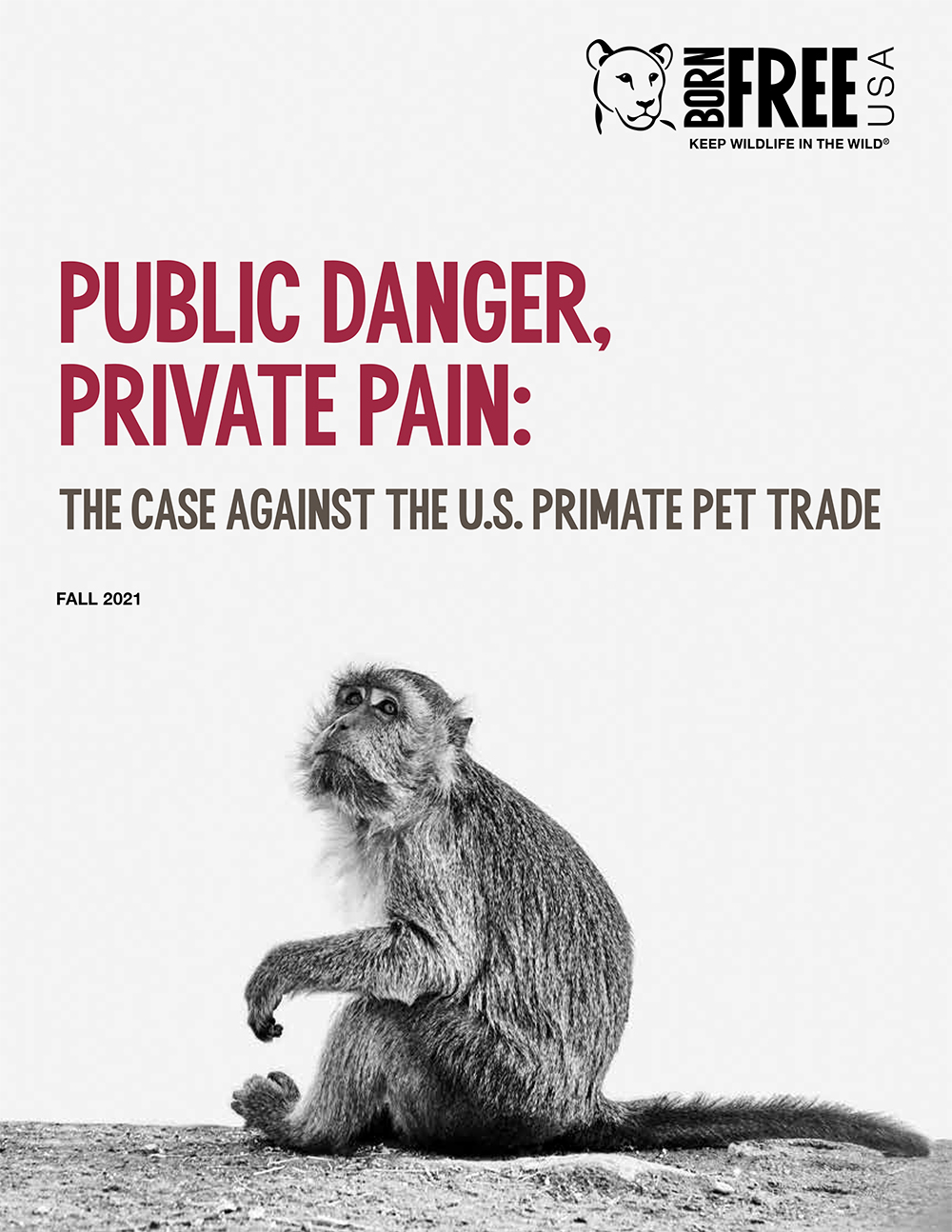
Contents
Primates as Pets in the United States: The Current
Landscape
Media Influence on Primate Ownership
Media Misconceptions and the Impact on
Primate Welfare
Case Studies: Monkeys Rescued by Born Free USA Primate
Sanctuary
A Global Perspective on the Trade in Primates as Pets
The Solution: The Captive Primate Safety Act
Introduction
In May 2021, the Captive Primate Safety Act (H.R. 3135/S. 1588 in the 117th Congress) was introduced in both houses of the U.S. Congress. If passed, this groundbreaking legislation will outlaw the private keeping of non-human primates (hereafter, “primates”) as well as most public interactions with primates in zoos and as part of other entertainment events. Introduced on grounds of public safety, the bill recognizes the significant risk posed to members of the public and those who are charged with dealing with emergency situations arising from the dangerous keeping of these wild animals as pets and using them in deliberate interactions such as photo ops, handling, petting, feeding, and other forms of inappropriate physical contact.
This report brings together expert voices – all with significant experience of working with and for the protection of primates in captivity and in their natural habitat – to explore the need for this legislation on grounds of public safety, as well as animal welfare, conservation, and to help curb the international trade in wildlife species. All speak in a united voice when it comes to their position on the Captive Primate Safety Act: its implementation is essential to end the dangerous and cruel U.S. pet trade, and to protect future generations of both human and non-human primates from harm.
Our Experts:

Brooke Aldrich, MSc
Brooke grew up in the United States but now lives in the UK. She coordinates the Asia for Animals Macaque Coalition, works for the Animals Asia Foundation, and is a trustee and director for Neotropical Primate Conservation. Her primate-related career began when she volunteered at a monkey sanctuary in the UK in 1999. She has since worked with, studied, and advocated for primates on four continents.

Erica Buhr
A 34-year-old mother of two, Erica is a software engineer. Erica purchased a monkey, whom she named Khy, as a pet and, on realizing that she could not give him the life he needed, rehomed him to the Born Free USA Primate Sanctuary. In this report, she shares the details of the realities of keeping a monkey as a pet in the United States.
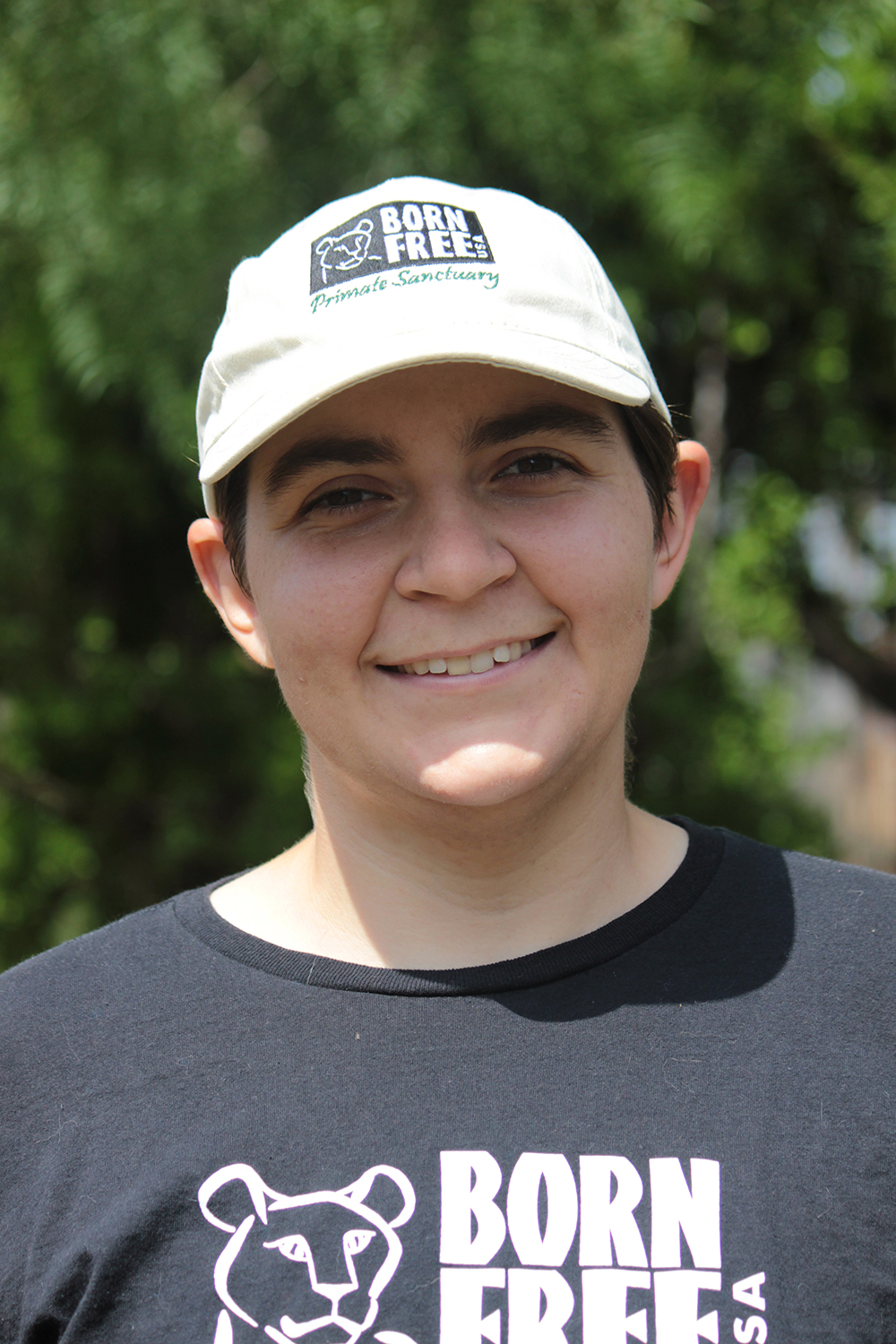
Katie Conway
Katie started working at the Born Free Primate Sanctuary as a Primate Caregiver in 2014 and was promoted to Sanctuary Manager in 2020. Katie has dedicated herself to working for animals for many years and, prior to joining Born Free, worked for several animal welfare, rescue, and rehabilitation organizations around the country and abroad. This included working for four months at a monkey sanctuary in Ireland and two years working caring for dogs, among other placements.

Tim Harrison
Tim is a retired Police Officer/Firefighter/EMT-Paramedic for the City of Oakwood, Ohio. He is the current Adjunct Instructor for the TEEX-National Emergency Rescue and Recovery Training Center at Disaster City (Texas A&M), and the Director of non-profit organization, Outreach for Animals. He is a published author of Wild Times, Tales from Suburban Safari, Wildlife Warrior, More Tales from Suburban Safaris, and White Magic, The Curse of the White Tiger, and the subject of the award winning documentaries, The Elephant in the Living Room and The Conservation Game. His mission is “to teach proper behavior around wildlife.”

Jhon Jairo Vázquez Gonzáles
Jhon Jairo Vázquez Gonzáles is the Director of Colombian non-profit, Fundación Maikuchiga, a sanctuary for monkeys and other animals orphaned from the wildlife trade, located in the southern Colombian Amazon, within the ancestral lands of the Tikuna community of Mocagua. An indigenous leader, Jhon’s work in primate rescue, rehabilitation, and release, as well as the development of sustainable livelihoods as an alternative to hunting of primates for local communities, spans more than 16 years.

Jennifer Place
Jennifer is the Director of Government Relations for Pike Associates, a boutique government relations firm located in Washington DC. In this role, she works with and assists Born Free USA with legislative and regulatory matters before Congress and the Administration. Throughout her more than ten years of professional experience, she has worked toward the conservation of endangered species, the protection of marine and terrestrial wildlife from cruel practices both in the U.S. and abroad, and has defended bedrock conservation laws like the Endangered Species Act and the Marine Mammal Protection Act. She works closely with congressional offices, federal agencies, corporations, small businesses, U.S. and international fisheries, and non-governmental organizations. She received a Masters of Public Policy and a Masters of Science.
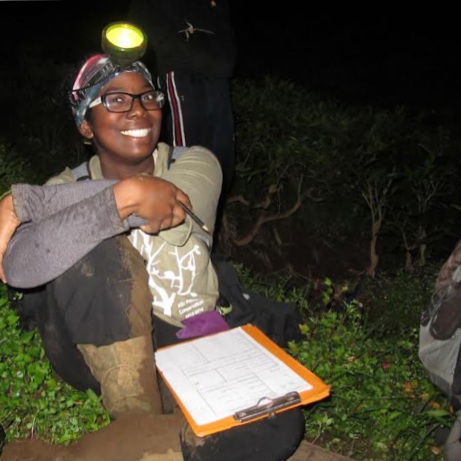
Dr. Stephanie Poindexter
Dr. Stephanie A. Poindexter is an Assistant Professor of Evolutionary Anthropology and an affiliate of the Environment and Sustainability departments at the University at Buffalo. She studies primate behavior, ecology, and conservation. Her research is based on wild and captive populations to address theoretical and practical primatology and conservation questions. Stephanie received her Ph.D. and MSc at Oxford Brookes University in Anthropology and Primate Conservation. Her work has taken her to Indonesia, Vietnam, Thailand, and various zoos in the United States and the United Kingdom.

Devan Schowe MSc
Devan is a Campaigns Associate for Born Free USA. She began studying captive wild animal welfare at Franklin & Marshall College, where she obtained a BA in Animal Behavior and English. She was introduced to sanctuary work with primates at the Born Free USA Primate Sanctuary, where she spent five years working as a Caregiver and Veterinary Assistant and eventually as Lead Animal Caregiver. She then received an MSc in Primate Conservation from Oxford Brookes University in 2019, focused on human/primate interface. She travelled to Thailand to conduct her final thesis, where she investigated the welfare of coconut-harvesting pig-tailed macaques. She published her thesis findings in a peer-reviewed journal in 2021.

Dr. Liz Tyson
Dr. Liz Tyson, LLB (Hons), PhD, FOCAE is Programs Director for Born Free USA, and has worked since 2004 in the field of animal protection and conservation, with a specific focus on primates. She is currently responsible for the management of one of the largest primate sanctuaries in the United States. Her academic expertise, and the subject of her many peer-reviewed publications, her book published by Springer Nature in 2020, and her doctoral research, is animal law. She has a particular interest in the way in which captive wild animals are protected (or failed) by legislation. Dr. Tyson is a Fellow of the prestigious Oxford Centre of Animal Ethics.
Primates as Pets in the United States: The Current Landscape
Conservative estimates suggest that, in the United States, more than 15,000 primates are kept as pets.1 Twenty-one states have already taken steps to explicitly ban private ownership of primates. The legislation differs immensely between the remaining 29 states: 13 states require a permit or license; six states require disease testing; and six states partially ban or require permits for some species but not all.
Nine states do not have any permit or licensing requirements relating to primates at all. For those states that demand permits, regulatory requirements range from simply obtaining a certificate of registration indicating the animal’s presence in the state that details their health, identification, and insurance, to having documented proof that the animal was obtained and transported legally, and/or paying a fee to obtain a wildlife ownership license. Only four states require that licensees dedicate a specific amount of time to animal husbandry before a permit is granted.
Counterintuitively, while most states classify primates as “inherently dangerous” or “prohibited” species, many still allow ownership through obtaining a permit or license; most of which are easily accessed with no previous experience in caring for such dangerous animals; no minimum housing standards; and no measures in place to mitigate disease risk. This patchwork of legislation not only presents a significant risk to both members of the public and animals in states where bans are not already in place, but also makes enforcement of existing laws difficult. Often, the victims of this lack of regulation are the animals themselves; members of the public who find themselves in the wrong place at the wrong time; and law enforcement officials who are called when things go wrong, despite having no formal training in how to deal with such incidents.
Tim Harrison, a retired Police Officer/Firefighter/EMT-Paramedic for the City of Oakwood, Ohio, who often responded to dangerous wild animal escapes and attacks during his career, spoke of the ease in which primates, including chimpanzees, can be obtained and the difficulty that comes later.
I deal with a lot of primates, of so many different kinds. There used to be 11 chimps kept in my area in Ohio that I know of; people don’t realize just how easy they are to get – it’s much easier that you think. Because either by word of mouth, or you go to the local fairgrounds, they’ll sell you something. Often, they are really bad people, and they are selling monkeys out of the back of their cars. There are cages just stacked on top of one another.
Erica Buhr, the former owner of Khy, a Japanese macaque who now lives at the Born Free USA Primate Sanctuary, confirms Tim’s account of the ease by which pet monkeys can be obtained.
I remember thinking it was really strange that you had to have a permit to get a squirrel, but monkeys were fair
game.
I found out about this exotic animal auction an hour away from where I lived. We got there early, we walked around and looked at all the animals in the cages. They had giraffes, zebras, all kinds of crazy things. Then I saw a breeder that was holding this little baby monkey that was two or three months old. That was Khy. He was so tiny. He had a little stuffed teddy bear that he was clinging to the entire time. At the time, I thought it was so cute, but looking back, it was just so sad. I remember during the auction it was just one woman and me bidding against each other. Afterwards, it was just a 15-minute talk with the breeder and then we were on our way.
And then I was like oh my god, what have I done?
The Dangers Posed by Primates
The lack of legislative prohibition enables uneducated, unequipped, and often misinformed individuals to own primates, despite many states acknowledging that they are dangerous wild animals. Experts agree that there is no way for them to be kept safely and in a way that does not significantly harm the animal, whether physically or psychologically. The danger posed by primates cannot be understated.
Primates are not domesticated. Domestication occurs over several thousands of years when a set of desirable physiological and psychological qualities are met, including high tolerance of proximity to humans, adaptation to a poorer quality diet, more frequent reproductive cycles, and maintaining physical characteristics from infancy into adulthood.2 Even when captively bred for multiple generations, primates do not demonstrate any of these traits, and the severe stress levels they experience in captivity often heighten their aggressive tendencies.
Injury
Irrespective of species, size, age, background, habituation to humans, within or outside of an enclosure, and with or without the humans involved having previous wildlife handling experience, primates will react in an unpredictable and aggressive manner in captivity. Even people with a relatively high level of animal husbandry expertise, including zookeepers and veterinarians, have reported injuries associated with aggressive and uncontrollable outbursts. Notably, “trained” primates including “service animals” have also been involved in these attacks.
Below are a very small number of the reported case studies evidencing the serious danger posed by privately kept primates. Additional incidents can be found here.
Tampa, Florida, 1999 – Angel the Capuchin
Angel was displaying affectionate behavior towards her owner. When her owner attempted to return the capuchin to her cage, Angel turned on her with no warning, biting her 50 times on the hands, arms, and right leg. The injuries were severe enough to require stitches.
Lansing, Illinois, 2000 – Zip the Macaque
Nine-year-old macaque, Zip, attacked his owner. His canine teeth latched onto her head, arms, and legs, causing injuries so severe that she lost half a pint of blood and spent ten days in hospital. Zip had attacked both the owner and the family dog prior to this incident and was killed as a result of this final attack.
Stamford, Connecticut, 2009 – Travis the Chimp
Charla Nash was attacked by her friend, Sandra Herold’s, pet chimpanzee, Travis. During the 12-minute attack, Travis destroyed Nash’s hands, nose, eyes, lips, and mid-face bone structure. She also endured significant brain tissue injury. Sandra believed Nash to be dead and screamed “He’s eating her!” to the 911 dispatcher as she called for help. Herold stabbed Travis in the back with a butcher’s knife in attempts to get him off of Nash but was unable to stop the attack. When police arrived, Travis smashed the window of the police car and moved to attack one of the officers. He was subsequently shot multiple times. Despite sustaining several serious injuries, Travis was still able to return to his enclosure, where he died. It was reported that the hospital staff who treated Nash were given counselling due to the nature of Nash’s injuries.
Chesapeake, Virginia, 2010 – Capuchin monkey
A U.S. veteran was attacked and severely injured by his pet capuchin monkey after he accidentally stepped on him. The capuchin monkey was a trained “service animal.”
Elk River, Minnesota, 2011 – Macaque monkey
A nine-year-old girl was bitten by a caged macaque, who was a trained “service animal.”
Okeechobee, Florida, 2012 – Macaque monkey
A nine-year-old pet macaque escaped his cage and attacked his owner when the owner attempted to catch him with a net. The owner suffered severe bites on his thigh and rear, and the monkey tore apart his right hand, exposing tendons and causing permanent nerve damage. A friend of the owner shot and killed the monkey.
Shallotte, North Carolina, 2018 – Japanese macaque
A Japanese macaque escaped his enclosure and attacked a woman in the neighborhood by biting and scratching her arms and legs. The monkey was shot and killed.
Shawano, Wisconsin, 2020 – Lemur
A woman suffered permanent nerve damage to her hand and now lives with Post Traumatic Stress Disorder (PTSD) following a pet lemur attack. The same pet lemur had previously attacked another woman, who required stitches in her hand.
Erica Buhr shared her firsthand experience of living with an increasingly aggressive pet monkey.
At about 23 months, Khy started getting aggressive towards me, and it got to the point that I was nervous to even go into his room to clean out his cage. As far as actual interactions go, there just wasn’t much, because I was afraid to be around him. He had bitten me three times in one month, and that had not been a thing before that. I really started to panic at that point. I started to reach out to a handful of primate sanctuaries around the country to try to find a good home for him.
I remember right after I found a space for him at the Born Free Sanctuary, going into Khy’s room and being so relieved but just so sad. I went and sat down in his room and let him out of his cage and he came out and cuddled up in my lap and I just started crying because I had finally made plans to find a new home for him and he was being sweet. As I was questioning my decision, I remember a teardrop fell on him and he looked up and attacked my face.
I don’t know what I would’ve done if Born Free hadn’t taken him in. Keeping him wasn’t an option, so I don’t know… I feel like I would have [had to have had him killed] because I don’t know how I could have lived with him. If you’re terrified of them at three pounds, imagine what they’re like at 30 pounds.
Disease
Nonhuman primates can transmit more than 200 known diseases to humans, many of which can be fatal, including Herpes B, Ebola,3 and SARS.4 Documented cases of humans transmitting diseases to primates include transmittal of Herpes virus 1,5 intestinal parasites,6 and measles outbreaks.7
Herpes B, for example, is carried asymptomatically by most macaque monkeys, a species that is popularly kept as pets. Untreated in humans, Herpes B is fatal in up to 80% of cases. In 1997, a researcher working with macaque monkeys in Georgia died after contracting Herpes B from a single “drop of virus”8 and, in 2021, a Chinese veterinarian died after contracting the virus.9 Despite this, macaque monkeys are often sold as pets, kept in people’s homes, and handled by their owners and their owners’ families and friends. The severity of zoonotic disease transmission has been underscored by the COVID-19 pandemic, which most likely originated from close interactions between humans and wildlife.
Public Interactions
Despite the undeniable risks of physical injury and disease transmission, wildlife safaris, zoos, animal rental agencies, and exotic petting zoos throughout the country actively encourage people to have direct physical interaction with primates on a regular basis. Our research found 46 facilities in the United States that offer 57 encounter experiences with primates. Primate interaction experiences include animal encounters (where people can pet, hold, feed, and/or touch the primates), animal shows with interactions, photo opportunities, and open-contact walk-throughs.
The types of facilities that returned results for primate encounters, 13 of which specifically advertised infant primates as part of their promotions, included zoos, petting zoos, animal shows, photo opportunities, animal rental agencies, and drive-through safaris. Three of the businesses advertised primates for sale on their website.
Facilities irresponsibly advertised their wild animals as “sweet and tame,” or “gentle, polite, and playful,” while others promoted their services by highlighting the animals as “rare and endangered.” Most of these facilities promoted their dangerous services under the guise of promoting wildlife conservation and using the animals to “educate” audiences about the species in the wild, despite featuring photos on their websites of the primates in unnatural situations including performing tricks, standing on people’s shoulders, or wearing clothing, diapers, or leashes.
One animal rental agency stated that patrons could “rent an exotic animal for outings to make life more exciting.” A zoo advertised a “Breakfast with the Monkeys” experience, in which guests could eat their breakfast with squirrel monkeys in an open-contact setting. Another zoo offered an orangutan feeding experience, in which visitors could feed orangutans while posing for a photo. A safari drive-through promoted the opportunity to hand-feed gibbons. An animal rental agency encouraged having a monkey “meet and greet” in a restaurant. As well as the clear health, safety, and sanitation risks posed by these profit-driven events, this irresponsible presentation of wild animals as tame and tractable ultimately damages serious protection and conservation efforts by legitimate organizations and individuals.
The Toll on First Responders
The foregoing case studies make clear that interaction with primates poses a threat to not just their owners, but to bystanders and members of the public who believe the false claims that monkeys and other primates can be tame and safe to handle. More often than not, however, when these animals attack or escape, first responders including paramedics, firefighters, and police officers are called upon to handle the fallout. However, and perhaps unsurprisingly, first responders are not trained to deal with escaped primates or other dangerous wild animals.
Tim Harrison expands on this crucial point.
I have found a chimpanzee loose in a house, a white tiger in a basement, a cougar loose downtown after chewing through a door, and people being bitten by venomous snakes in our area and dying from it. Nobody taught us anything. I couldn’t get any information from anyone about how to handle these animals, so I basically learned on my own. There are no schools, no police academy, fire school, or animal control teaching you how to handle primates. And every cop, every department, has these stories, and the majority of the officers have PTSD after dealing with these incidents. After a particular incident, one of the guys quit the department to teach at a college. He couldn’t be a paramedic anymore because he lost his friend. The other two guys involved just couldn’t work anymore. People don’t realize. When there’s a chimp attack, or a big cat attack, it’s not like a car accident. No matter what you do, it’s not going to save [the victim].
When Travis the chimp ripped open the police officer’s car door, he just barely got to his sidearm and shot him, and still didn’t kill him. Travis went back into the house and the other officers had to respond with shots. Everyone said “just shoot him,” but it doesn’t work that way.
And they don’t want to shoot these animals either; they’re beautiful creatures. Take [the Zanesville Massacre in Ohio]. Some of those tigers had to be shot 16 or 17 times before they went down, and that’s just cruel. But there’s nothing we can do about it because we don’t have the weapons for it. You would need 50 caliber rifles, like big game hunters, and to be able to discharge them safely in a residential community. I don’t want 50 caliber weapons in my community, so I definitely don’t want these poor animals to be in there because they’re going to be the ones that pay the price. When an animal escapes, about 90% of the time they are shot and killed.
People always came at me asking what else I could have done. We could have made our governor fill out the paperwork to keep these animals out of people’s homes and have legislation beforehand or these animals wouldn’t have been there. It’s that simple. Every cop says, “we want legislation.” It’s just basic. Get some legislation, common sense legislation, protect the first responders, protect the public, and protect the animals.
Media Influence on Primate Ownership
In 2016, research on the online sale of wild animals published by Born Free USA, Downloading Cruelty, found that ads featuring primates were the most numerous compared to other wild animals, including big cats, canids, and snakes. Videos of captive primates circulating on social media often depict unrealistically positive interactions between the owner and primate. This content perpetuates the false narratives that primates are safe to keep as pets and that primate populations are stable in the wild.10 Further, the inaccurate perceptions that many viewers adopt after watching such videos has been linked to increases in the demand for exotic pets.11
According to Tim Harrison:
Once reality TV started, whatever you saw on TV was for sale the very next couple months, and I’m not exaggerating that. When we asked, they would say, “I just saw Monkey Heaven on Animal Planet.” It was just connecting the dots… especially for law enforcement. If the little squirrel monkey [wasn’t] good enough, [they would get] a chimp. They truly love these animals sometimes, but they’re loving them to death. People [would bring] these animals into their homes. It goes directly from there to an attack or an escape. There’s never a happy ending with a primate.
Primatologist Brooke Aldrich provides a deeper insight into the way in which media, including social media platforms, contribute to misconceptions about primates and further fuel the pet trade in the following article.
Media Misconceptions and the Impact on Primate Welfare
By Brooke Aldrich MSc
Did you know that in the first century AD, the Romans brought many thousands of exotic animals, including monkeys and apes, into the city’s arenas to be killed by gladiators for the enjoyment of the crowds? Or that in the “sports” venues of 1850s London, monkeys were sometimes pitted against fighting dogs in ferocious combat?
Looking back, it is easy to see how inhumanely humans have sometimes behaved towards other animals for the sake of “entertainment.” Unfortunately, animals, including primates, are still sometimes brutally and pointlessly persecuted for amusement’s sake, not only in hidden back rooms or the murky corners of the Dark Web, but also on thousands of easily accessible YouTube channels, private Facebook groups, and other hugely popular social media platforms.
Luckily, people who love animals can easily recognize this sort of cruelty and are often vocal in condemning it. But what about those primates who appear on film, TV, or social media in seemingly cute or harmless ways? How could this be a problem?
For many years, I have been interested in the ways people think about (non-human) primates, why, and what impact this might have on the primates themselves. Some time ago, I asked my father, who grew up in Missouri in the 1940s and 1950s, how big he thought a chimpanzee could get. Turns out, my well-educated dad thought that a large chimp might possibly reach the size of a German shepherd dog, but would never be as dangerous. And why did he think this? Well, as a kid, his parents often brought him to their local zoo to watch the animal shows, which always included a chimpanzee riding a bicycle. Dad had no idea that the chimps in those shows were youngsters who had been removed from their mothers, or that adult chimpanzees can grow up to five or more feet tall. He had no idea that their big “smiles” were actually expressions of fear or submission. Up until our conversation, Dad had no idea just how dangerous adult chimpanzees can be.
Suspecting that this was not a unique story, I looked more closely into the matter. I asked a group of people living in the UK whether (among other things) they thought that adult chimpanzees are usually “about the size of a German Shepherd dog.” Only 30% of them disagreed with that statement. The majority thought that big wide grins, usually expressions of submission or fear in most primates, were expressions of happiness.
Around the same time, I watched all the trailers I could find for 20 years’ worth of the movies featuring primate “actors.” Paying close attention to exactly how they appeared in these trailers, I found that these primates were almost exclusively shown with human companions, and in human environments like houses, shopping malls, or ski slopes. Half the time, they were clothed, and they were “grinning” for about 20 percent of the time they were on-screen, always in contexts that suggested they were having fun. As a primatologist and a person who has spent a lot of time with rescued primates, I can tell you with certainty, they were not.
Given the way primates are so commonly depicted in popular media, is it any wonder that people get the wrong idea? Mine was neither the first nor the last research to suggest that the way we repeatedly see primates is likely to be the way we think of them. And far, far too often, we see them in film, television, and social media in contexts that are totally unsuitable for them, and often dangerous for us. A pet monkey in a New York City apartment? Great idea! A cute companion who can be happy in my human household? Why not? An adorable baby chimp in diapers on Instagram? Bring it on!
There is no such thing as a “domesticated” primate. Primates are by nature wild animals, and most often extremely social animals, and close contact with humans is rarely in their best interest. No matter how much love we have to give, they cannot live optimal or even “good enough” lives as pets. You may know this, but you just have so much love to give! What could be wrong with just posting that photo of yourself with the adorable lemur at the fair? With that young monkey they let you hold at the “rescue center?” How could posting a video of an adorable slow loris eating rice cause anyone harm?
It is not just about the harm that may have been done to the animal you are being photographed with. Chances are, if you are given the opportunity to pose for a photograph with a primate or any wild animal, some harm has been done – wild animals do not willingly come into contact with a series of strangers under normal circumstances. Even in cases where free-living monkeys live closely alongside people, they are there because they are fed, which inevitably results in conflict. The monkeys are rarely the winners in such cases.
Just as importantly though, images of primates in human homes, doing “human” things – or even just with human companions – such images send the message that this is fine, this is normal, this is safe, this is even desirable. They send the false message that primates can thrive in close contact with people. That it is safe and humane to interact with them. They are cute, we love them, and that is all that matters. The result of this sort of thinking is that more monkeys are kept as breeding stock, giving birth to baby after baby, only to have those babies taken away and sold to supposedly “loving” owners. Or, in other places, because all these forms of media are global, more mother primates will be killed and their babies taken and sold as pets. More young monkeys will be brought up as though they were small humans, or living dolls. They will be confused, unable to express themselves in ways that come naturally to them. They will be at risk of the illnesses and abnormalities that develop in so many captive primates, even those with well-meaning owners. The people around them will be at risk too – because even small primates easily become unmanageable and surprisingly dangerous. They are wild animals, after all.
Even the luckiest, most-loved, best-cared for pet primates live nothing but pale shadows of the lives they should be living in the wild. You may know this, and you may love animals – perhaps this is exactly why you want to show the world that photograph of yourself holding that adorable baby monkey! Please, though, remember this: pictures are worth a lot more than a thousand words. Pictures tell us stories that shape not only our own attitudes and actions but also those of the many people that see them. That “cute” video of the monkey in the snowsuit? That hilarious episode of Community? That excellent selfie you took when you were travelling? Sharing them has consequences. This is becoming increasingly apparent, and we all need to do our part in behaving accordingly.
The Impact on Animal Welfare
Primates kept as pets and used in performances experience substantially poor welfare for the entirety of their lifespans in captivity, which in many species ranges upwards of 35 years. They suffer extreme isolation and social deprivation from other primates throughout their lives, as most owners purchase them as infants. Members of many primate species spend their entire lifetimes with their mothers in the wild, which makes separating them at such an early life stage especially damaging. This separation robs the animals of fully developing proper maternal and conspecific bonds, which most primates, being some of the most socially dynamic and complex animal species in the world, retain throughout their lives. Inhibiting crucial developmental stages often results in abnormal brain development and thus abnormal behavioral expression later in life.12
These abnormal behaviors have been documented to closely resemble Post-Traumatic Stress Disorder (PTSD). They include hyper-vigilance, aggressive outbursts, excessive fear, and self-directed aggressive behaviors such as self-biting, hitting themselves, hair plucking, and rocking.13 Behavioral deficits may be further exacerbated by the inability of private owners to provide species-specific spatial and environmental needs, which result in malnourishment, stunted growth, physical deformities, illness, injury, boredom, and increased aggression.14
Some primate species have natural home range sizes of up to 30 square miles and consume extremely specialized foods that greatly depend on seasonal fluctuations within their natural environment, including plants, fungi, fruits, seeds, and small invertebrates.15 Simply put, it is impossible to create an environment for primates that fully meets all, or indeed any, physical and behavioral needs in captivity. The social structure, space allocation, environmental diversity, and intricate diet remain much too complex for any owner to replicate in their home or performance exhibit.
In addition to these extreme mental traumas, captive primates often endure painful physical complications due to the difficulty most owners find in attempting to treat them medically. Many owners are unable to recognize the signs of ill health in their pet primate. If they recognize that something is wrong, the cost of a specialist veterinarian, or even finding a vet who is qualified and willing to treat the animal, is often extremely difficult. Therefore, more often than not, veterinary care is never provided.
Katie Conway, Sanctuary Manager at the Born Free Primate Sanctuary, shared her experience of providing care to victims of the primate pet trade:
Usually [rescued monkeys] arrive very pale, thin, and weak. It breaks my heart to see the damage caused by the trauma they have experienced. They have trouble climbing around the space we provide that is usually much bigger than anything they have experienced before. Many exhibit stereotypical behaviors like self-biting or hair plucking that can stay with them the rest of their lives. Some of them are fearful, or very aggressive. Captive-raised monkeys have a lot more physical and mental health problems. When you take a monkey away from their natural environment and family, they are going to suffer no matter how well you try to treat them. The unhealthy coping mechanisms they have developed to deal with extreme stress don’t exist in free-living monkeys – it is a product of captivity.
Free-living monkeys also grew up learning proper social skills. They may fight, but they understand each other’s signals and know when to back off. Captive-raised monkeys are more likely to fight for reasons that wild monkeys wouldn’t, and they can [fight] until they are severely injured.
While the animals themselves undeniably suffer immensely, those people who try to keep them as pets also experience stress, damage to their property, as well as constant threat of injury. Erica Buhr, shared her experience of trying to care for Khy in her home:
It was chaos. Khy was escaping regularly. Everything I valued had become covered in monkey poop and slimy hands and just disgusting. As a parent now, I think about how difficult it was to baby-proof our house, and there is just no such thing as monkey-proofing your house. They can climb anywhere, they can get into anything, they know how to use their thumbs, it’s just impossible.
[Having Khy] was really stressful. Back when I was young and I didn’t think I wanted kids, it didn’t really occur to me to think about all the reasons I thought I didn’t want kids and see how that applied to having a pet monkey. Because you can’t travel, can’t go on vacations, you can’t just have someone come and watch your pet monkey for a few days when you go out of town. It’s a full-time responsibility. I was just watching as my living situation deteriorated because everything was broken or covered in disgusting everything. No matter how smart or prepared you think you are, it’s never going to work out.
Case Studies: Monkeys Rescued by Born Free USA Primate
Sanctuary

Betsy – Guinea Baboon, 38 years old
Betsy was kept illegally as a pet for 30 years in Louisiana. When she was just 18 months old, her trauma was so severe that she had to have surgical amputations after she ate parts of her own feet and tail. She spent most of the next 28 years in a small cage without any companionship of her own kind. Her owner surrendered her to the Born Free USA Primate Sanctuary in 2017. Since then, she has learned to live with other baboons, but she remains much more interested in humans than other monkeys. She swings quickly from being excited to fearful and will often be seen carrying a blanket or small stuffed toy as a comfort object.
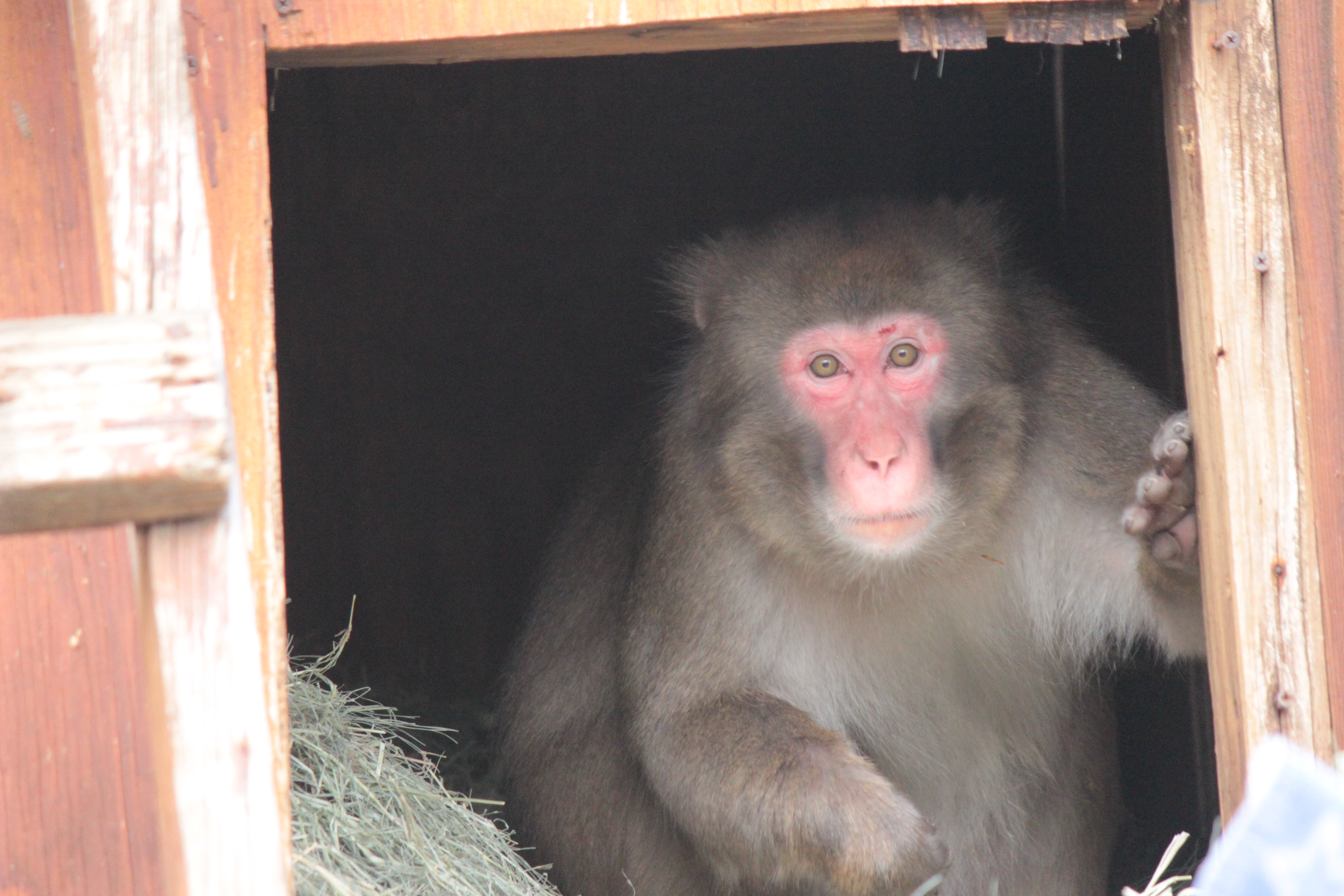
Charlie – Japanese macaque, 7 years old at time of death
Charlie was a Japanese macaque who was kept as a pet until he was around six years old. As he grew bigger and stronger, he became more and more aggressive. This culminated with him biting his owner’s young grandson, who was hospitalized as a result. The authorities threatened to kill Charlie, but a campaign by a local animal welfare organization saved him, and he was taken into the temporary custody of a local animal shelter. From there, he was moved to a wildlife sanctuary in Texas, but they had no companions for him and so he was finally moved to the Born Free Primate Sanctuary in December of 2018.
Despite the best efforts of the expert staff, as a result of his past trauma, Charlie never settled at the sanctuary. His behavior ricocheted between fearful to hyper-aggressive, which often lead to fights with other monkeys. One day, almost a year to the day after he arrived, Charlie was found deceased in his enclosure. He was physically perfect and there was no obvious cause of death. It took a detailed pathology investigation to learn that the cause of his death was the cumulative impact of his years of trauma. He, literally, died from stress.
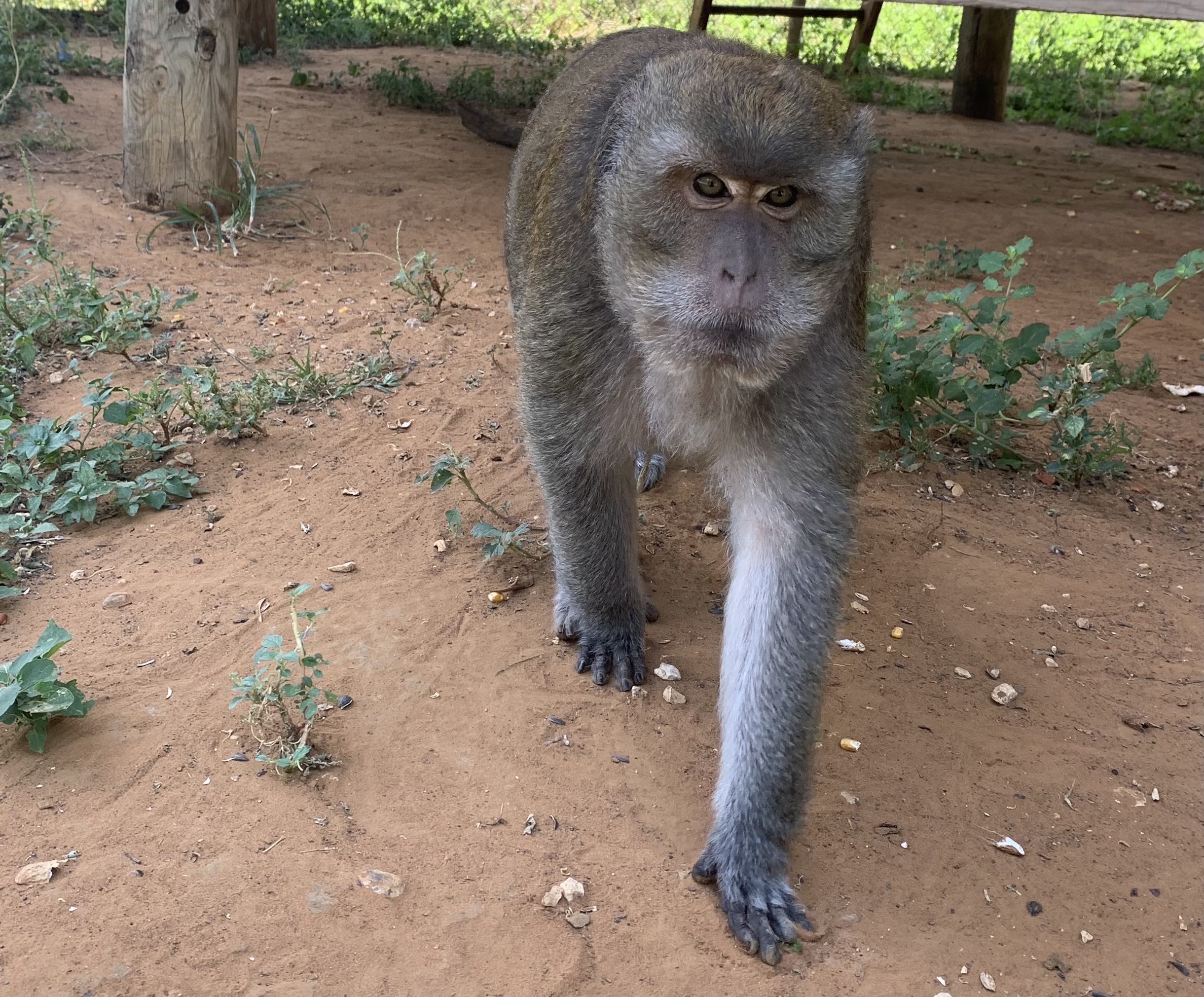
Freeman – Long-tail macaque, 20 years old
For ten years, Freeman lived in a cage that was 3’ x 3’ x 2’. He was never allowed out of his cage, and the cage was never cleaned. He never saw the sun, nor did he ever have access to any fresh air. He was fed dog food and table scraps, as well as being given alcohol and marijuana.
Freeman was brought to the sanctuary in 2012, after his former owner was convinced to relinquish him. He has thrived at the sanctuary, despite his traumatic past. While he still has bouts of aggression, he has lived nicely with multiple other monkeys, and is usually very gentle and friendly with them. He now lives in a big enclosure with two other long-tailed macaques named Sissy and Felix. He spends a lot of his time sitting and grooming or being groomed by his friends. He continues to struggle with health issues, as do most ex-pets.
Sanctuary is Not the Solution
While some case studies in this report include the stories of monkeys rescued and rehomed with sanctuaries, sanctuary is not the answer to the problem of the primate pet trade in the United States. There are only around 20 accredited primate sanctuaries in the U.S. and, collectively, they provide homes to fewer than 1,500 monkeys rehomed from the pet trade, laboratories, zoos, and other situations. With approximately 15,000 primates currently in the pet trade, and an estimated 75,000 in laboratories, it would be impossible for this small network of non-profit organizations to provide lifetime sanctuary for even a fraction of the animals in need.
Most sanctuaries across the United States are either close to or at full capacity and, at best, can provide homes to a handful of animals each year. Funded predominantly by donations from members of the public and grant-giving trusts, the financial costs of care are high and, until the trade is stopped at the source, sanctuaries are little more than “a band aid over a bullet hole.” To put this into context, we extrapolated the cost and space ratios currently provided for monkeys at the Born Free USA Primate Sanctuary as a means to understand the potential costs of providing sanctuary to all of the animals currently exploited in the U.S. primate pet trade.
- 6,104 acres of sanctuary space, including animal enclosures and associated operating infrastructure (equivalent to 4,598 football fields16);
- $225 million US dollars to
cover construction costs to provide minimum space enclosures for every monkey; - $337 million US dollars for lifelong care (based on a 20-year lifespan from time of arrival);
- 1,350 minimum staff members, and 45 years of operation.
In addition to the fundamental lack of infrastructure available for ex-pets, a primate struggling to adjust to life after rescue is a familiar scenario for most sanctuaries. Any caregiver can describe the difficulty of helping an ex-pet or previous zoo resident assimilate to sanctuary life. The primate will often take their first steps outside, see the sun, feel grass under their feet, hear birds, see other primates, be able to escape stressors, move around a large enclosure freely, obtain access to medical care, and eat an appropriate diet for the first time.
Once integrated into their new life at the sanctuary, the behavioral adjustment is often a slow and arduous process. Some arrive at sanctuaries never having eaten fruits or vegetables. In these cases, caregivers must fill this initial calorie deficit with “human foods” and slowly ween them off until they willingly eat a proper, nutritious diet. Some primates experience such severe malnourishment and associated medical diseases that they must remain on a medication regimen for the rest of their lives. Others, like Charlie, whose story was told above, die years before their natural life expectancy due to medical complications associated with chronic stress.
The lack of normal developmental opportunities suffered by ex-pet primates often results in these individuals struggling with basic social interactions with other primates. Although most primate species evolved to live and thrive in large groups, those individuals who grew up in isolation often fail to understand basic behavioral cues in group living situations. Therefore, introducing them to others can be an incredibly dangerous and challenging task. Behavioral deficits cause these primates to react to social cues inappropriately, which can inhibit them from forming a normal bond with others of their own kind. Additionally, the abnormal behaviors most primates learn as coping mechanisms during times of extreme stress as a pet or source of entertainment (e.g. self-harm, rocking, excessive pacing, and increased aggression) can interfere immensely with normal behavioral interactions.
As a result, although sanctuaries strive to replicate a wild environment in every way possible for their rescued residents, sometimes this is not always possible if they are too damaged to function properly and cannot coexist safely with other primates. Primates rescued from the pet trade or entertainment industry will never be released into the wild due to their inability to execute these basic survival skills, and therefore will never experience freedom. The sad reality of sanctuaries is that, although providing a quality of life far superior to that experienced up to the point of rescue, it is not a “happily ever after” solution. The effects of the primate trade for private possession are far too pronounced and often irreversible.
A Global Perspective on the Trade in Primates as Pets
In addition to habitat loss and climate change, the private ownership trade accounts for one of the top three most destructive factors driving primate species towards extinction.17 Removing primates directly from natural habitats to accommodate demand and social media promotion of primate pets and performers (particularly infants) contributes substantially to decreases in wild populations. While countries like the U.S. allow the private keeping of primates, the legal trade also masks any illegal trade that occurs, both domestically and across international borders.
Further, in endemic countries that can release rehabilitated primates back into the wild, any diseases transmitted from humans to nonhuman primates could impact their population status if spread to wild populations, or vice-versa for those wild-caught primates introduced to captive populations. While most primates in the U.S. pet trade were bred for profit within the country, wild-caught monkeys do still find their way in and are sold as pets. The capture of a free-living monkey will often result in the killing of many other members of their troop.
The continued legal trade in primates in the U.S. also sends a message to other countries that the cruelty of keeping primates as pets is both acceptable and desirable. This has a domino effect for those working in primate range states to end the trade there. The private trade of primates not only decreases the quality of life for so many individuals taken from the wild, but also perpetuates a cycle within many communities of viewing primates as commodities to be hunted, possessed, or a source of profit, which further contributes to fueling this trade.
Jhon Vazquez, the Director of Fundación Maikuchiga, a non profit primate sanctuary located within the Tikuna indigenous reserve of Mocagua on the banks of the Amazon River in Colombia, offers some insight into the importance of legislative change in the U.S.:
The U.S. has a global reputation with regard to animal welfare and wildlife protection, which other countries follow. They need to make bold decisions, and in making those decisions, they need to 100% consider the lives of the animals. They need to respect them. The laws can’t have room for negotiation, and they must include strong sanctions to be effective. One of the main impacts for us if this law [The Captive Primate Safety Act] is introduced – will be a knock-on effect in other parts of the world. It will set an example for South America, for Colombia, to understand how important it is to respect the rights of these animals. If the U.S., with how large it is, and how complex its governance is, can achieve this, then it is like “Wow – if they can do it, we can do it.”
Vazquez also spoke to the challenges of rehabilitating and releasing monkeys who had been kept as pets in their natural habitat; something which is impossible for monkeys kept in the U.S., but sometimes possible – although never guaranteed – if they are rescued by Jhon and his team when they are young enough to learn to survive in the forest.
Rehabilitation is a really complex process, and it is the work of a lifetime. Each species, each individual monkey, has different needs. They have different behaviors, and different visions. Rehabilitation is also complex when the monkeys are living near indigenous communities. If they have spent a lot of time living with humans, they may get too close to the communities, or they may be hunted, so our release sites have to be really carefully selected and the process very carefully managed.
For some monkeys, adapting to a more natural life, becoming independent, and integrating into a troop comes naturally, and they just need to be given the opportunity to do so. For these monkeys, we support them while they need us, then take them to the forest and release them, continuing to monitor them until they can live truly independently. For others, it is hard, and the process does not go so well. If they have been kept in a human home for a long time, eaten human food, never been around monkeys, not been raised by monkeys, it can be really hard to rehabilitate them. They might thrive at the sanctuary while they continue to receive daily care, but then, when we try to release them, they try to follow us back, they get depressed. For some, rehabilitation is simply not possible, and some don’t survive at all.
But, however challenging rehabilitation is for any individual, living as a pet is worse. They are prisoners. They have no freedom, they never see the sun, they live in a cage, and they cannot explore the world. However hard the process of rehabilitation might be, life as a pet is worse. It is so much worse. Even if you think you can care for them well, they are prisoners. Your home will never be their home. While you might want to experience their beauty, their charisma, their character, they just want to be free.
Dr. Stephanie Poindexter elaborates on the global implications for the trade in primates as pets in the following article.
Global Implications of the Trade in Primates as Pets
By Dr. Stephanie Poindexter
Knowing that primates are freely bought and transported around the United States threatens wild populations. Several reactions are triggered by merely seeing a primate as a pet: some people may want one for themselves, perceive them as less wild, or think there must be an abundance in the wild. All of these reactions will hurt the already declining wild populations of most primate species.
From my perspective as an American primatologist that works within the wild geographic range of primates, limiting the sale within the United States will have a global and cascading effect. Now more than ever before, we live in a highly globalized world, where one social media post in the United States can drive demand for exotic animals within their endemic geographic range across the world. It can be hard to imagine how the actions of people so far apart from one another can have a lasting impact, but it does. Regardless of what part of the world you live in, if you are looking for a primate to have as a pet, you turn to the internet. The worldwide web will give you access to what you want and if one of the most popular videos or links are of someone in Florida hugging a South American capuchin wearing a dress, you may feel inspired to find your own “cute” capuchin to dress up, too. Content from the United States is very popular and reaches beyond our shores. I have seen first-hand the power of social media in driving the primate pet trade outside of the United States, from increasing individual desire to have a cute slow loris after seeing an Instagram post to the elaborate online marketplaces facilitating the sale and purchase of endangered primate species. Many of the primates that end up in the pet trade globally have come from wild populations. As a primatologist focused on understanding and maintaining wild primate populations, the pet trade is a persistent opposing force to that mission.
The Captive Primate Safety Act is needed to tell the global community that the United States is actively working to prioritize primate welfare and is committed to curbing their presence in the pet trade. It will also have a global impact as limiting access can curb demand, making it increasingly more difficult and riskier to get a primate pet, in turn minimizing the lure of having a primate pet at all.
I have stood among the towering aisles of small cages filled with wild animals being sold as pets in various markets throughout the world. Shuffling down those hot narrow aisles, it is hard to feel anything other than despair. That feeling is compounded once you have seen the way their wild counterparts freely move throughout the forest. Primates that are captured in the wild for the pet trade endure levels of stress that have lasting negative effects; effects that will hinder their physical, mental, and social health in the present and the future. Even if these captured primates are lucky enough to be confiscated by local authorities and reintroduced to the wild, they will likely pass those effects of that stress on to later generations, if they even survive at all. If you appreciate animals, biodiversity, or the environment, there is no context in which seeing a wild animal in private ownership elicits a feeling of joy. Primates in their wild habitats are enchanting and awe-inspiring. Once you have experienced that beauty, it is hard to see them exploited by humans for companionship or entertainment. The ease with which people in the United States can simply buy a wild animal and have it flown to their home signifies the level at which these dynamic and dangerous animals are just seen as commodities. I know this is not the way we want to be represented and ending the U.S. primate pet trade truly sends a message that these animals should be valued and in environments where they can thrive as they would have if living in the wild.
The Solution: The Captive Primate Safety Act
It is clear from the forgoing information and the first-hand testimony of those people closest to the cruel trade in primates as pets that the status quo is unacceptable. Allowing the keeping of primates as pets to continue in the U.S. threatens public health and safety, animal welfare, and global conservation efforts. Thankfully, there is a solution. Jennifer Place, Director of Government Relations at Pike Associates, LLC, offers her perspective on why creating legislation restricting private ownership and interactions with primates is the vital solution to end the trade once and for all.
Congress Must Act Now to Protect People and Primates
By Jennifer Place, Pike Associates, LLC
When you think of wild animals in captivity, it is possible you think of zoos and aquariums, zoological theme parks, perhaps even roadside zoos and private or semi-private menageries. Thanks to the 2020 docuseries, Tiger King, you may even think of Joe Exotic and the seedy world of breeders, exhibitors, and exotic pet owners.
But do you think of the United States Congress?
Over the course of a decade as a federal lobbyist in DC, I have been to a surprising number of events, receptions, and briefings on Capitol Hill that feature wild animals. I have seen throngs of people – Hill staffers, fellow lobbyists, and more – stand in awe before a bald eagle, hold a python in hesitant fascination, cuddle with far-too-young baby tigers and lions, and hold a diapered newborn chimpanzee.
These events, not to mention the murky world behind them – breeders, exhibitors, unscrupulous and profit-hungry facilities, exotic pet owners, etc. – are not only cruel but dangerous. The simple truth is that the private keeping of and direct interaction with wild animals in these types of captive situations presents a very serious risk to public safety and health. The other side of that coin are the animals themselves; these are wild creatures, hard-wired over thousands of years to live in unrestricted freedom, often – and especially the case with primates – in family groups and with others of their own kind. Subjecting them to captivity will, at the very least, frustrate their natural instincts and more often than not sentence them to lonely lives, full of boredom, isolation, and suffering.
This is why Born Free USA is working diligently on the Captive Primate Safety Act. This bill, if enacted, would amend and strengthen existing to law to address these issues. Not only would this bill ban the interstate and foreign commerce of non-human primates, but it would also ban the private possession of these animals. Taken together, these prohibitions will largely eliminate the rampant, cruel, and dangerous primate pet trade. But, the bill does one more thing – it bans direct public contact with primates. This removes an added risk to public health, given that primates may carry multiple zoonotic diseases that can be passed to humans, as well as preventing avoidable injury.
Born Free USA has long been a leader in crafting and advocating for this bill. From our work at the primate sanctuary, we have seen firsthand the abuse and neglect “pet” primates receive, and we have heard countless horror stories of the consequences that come when these animals succumb to their frustration and thwarted natural instincts. But, even if we had not witnessed any of that, we would still know with utter certainty that wild animals belong in the wild.
Over the last few years, incredible strides have been made in educating Congress on the perils and cruelty of keeping wild animals in captivity. It is time to put words to deed and pass the Captive Primate Safety Act – to protect us and to protect wild animals.
Conclusion
Given the risks that privately owned primates pose to public health and safety, ineffective current legislation, grave welfare concerns, and the harm this trade poses to the survival of wild populations, it is difficult to see much reason to maintain inconsistent legislation as it currently is and continue to permit the legal private ownership of primates throughout the United States. Public interactions with and private ownership of primates directly puts the public in danger; as the data have indicated, it is only a matter of time before an escape or attack occurs. The severity of these incidents is often up to chance.
Although each expert opinion presents a different perspective, the consensus among them is in resounding agreement that private ownership must be federally banned in the interests of both human and non-human primate welfare. No number of adjustments to individual state laws, regulation improvements to USDA standards, disaste incident trainings for first responders, or stricter disease-testing requirements would improve the current threat that primates pose every day they continue to be held captive.
The unpredictability of primates during escapes or attacks and increasing emergence of new zoonotic diseases renders any legislation other than a federal ban illogical and negligent of public safety concerns. Further, sanctuaries continue to burn through valuable resources to rescue unwanted privately owned primates that would be prevented from entering this trade in the future with effective federal legislation.
With this report, we hope that law makers, wild animal facility owners and employees, exotic animal vendors and breeders, international trade experts, veterinarians, conservationists, and welfare specialists will recognize the risks primates pose to the public, unite in agreement that this trade must end, and do all they can to ensure the successful passage of the long-overdue Captive Primate Safety Act.
References
- Mott, M., 2021. The perils of keeping monkeys as pets. Animals. Available at: https://www.nationalgeographic.com/animals/article/news-monkeys-primates-pets-trade-ethics#:~:text=The%20Allied%20Effort%20to%20Save,pets%20in%20the%20United%20States [Accessed August 30, 2021].
- Driscoll, C., Macdonald, D., & O’Brien, S., 2009. From wild animals to domestic pets, an evolutionary view of domestication. Proceedings of the National Academy of the Sciences, 106, 9971–9978.
- Brown, D. W. G.,1997. Threat to humans from virus infections of non-human primates. Reviews in Medical Virology, 7, 239–246.
- Greatorex, Z. F., Olson, S. H., Singhalath, S., Silithammavong, S., Khammavong, K., Fine, A. E., & Mazet, J. A. K.,2016. Wildlife trade and human health in Lao PDR: An assessment of the zoonotic disease risk in markets. PLOS ONE, 11(3), p.e0150666.
- Huemer, H. P., Larcher, C., Czedik-Eysenberg, T., Nowotny, N., & Reifinger, M.,2002. Fatal infection of a pet monkey with human herpesvirus 1. Emerging Infectious Diseases, 8(6), 639–641.
- Jones-Engel, L., Engel, G. A., Schillaci, M. A., Froehlich, J., Paputungan, U., & Kyes, R. C., 2004. Prevalence of enteric parasites in pet macaques in Sulawesi, Indonesia. American Journal of Primatology, 62(2), 71–82.
- Brown, D. W. G., 1997. Threat to humans from virus infections of non-human primates. Reviews in Medical Virology, 7, 239–246.
- Bragg, R., 1997. A drop of virus from a monkey kills a researcher in 6 weeks. The New York Times. Available at:
https://www.nytimes.com/1997/12/14/us/a-drop-of-virus-from-a-monkey-kills-a-researcher-in-6-weeks.html [Accessed August 30, 2021]. - Tan, R., 2021. China reports its first death of a human from rare Monkey B virus. The Washington Post. Available at: https://www.washingtonpost.com/world/2021/07/19/monkey-b-virus-china-human/ [Accessed August 30, 2021].
- Nekaris KA-I, Campbell N, Coggins TG, Rode EJ, & Nijman V., 2013. Tickled to death: Analysing public perceptions of ‘cute’ videos of threatened species (slow lorises – Nycticebus spp.) on Web 2.0 Sites. PLOS ONE, 8(7), p. e69215.; Nekaris, K. A. I., Musing, L., Vazquez, A. G., & Donati, G., 2015. Is tickling torture? Assessing welfare towards slow lorises (Nycticebus spp.) within Web 2.0 Videos. Folia Primatologica, 86(6), 534–551.
- Sollund R., 2011. Expressions of speciesism: The effects of keeping companion animals on animal abuse, animal trafficking and species decline. Crime, Law and Social Change, 55, 437–451.
- Mallapur, A., & Choudhury, B. C., 2003. Behavioral abnormalities in captive nonhuman primates. Journal of Applied Animal Welfare Science, 6(4), 275–284.
- Lopresti-Goodman, S.M., Kameka, M., & Dube, A., 2013. Stereotypical behaviors in chimpanzees rescued from the African bushmeat trade. Behavioral Sciences, 3, 1-20.
- Duarte-Quiroga, A. & Estrada, A., 2003. Primates as pets in Mexico City: An assessment of the species involved, source of origin, and general aspects of treatment. American Journal of Primatology, 61(2), 53-60.
- Clutton-Brock, T.H., & Harvey, P.H., 1977. Primate ecology and social organization. Journal of Zoology, 183(1), 1–39.
- Figures extrapolated from average space per monkey at the BFUSA Primate Sanctuary (which is larger than most).
- Estrada, A., Garber, P., Rylands, A., Roos, C., Fernandez-Duque, E., Di Fiore, A., Nekaris, K., Nijman, V., Heymann, E., Lambert, J., Rovero, F., Barelli, C., Setchell, J., Gillespie, T.,Mittermeier, R., Arregoitia, L., de Guinea, M., Gouveia, S., Dobrovolski, R., Shanee, S., Shanee, N., Boyle, S., Fuentes, A., MacKinnon, K., Amato, K., Meyer, A., Wich, S., Sussman, R., Pan, R., Kone, I. & Li, B., 2017. Impending extinction crisis of the world’s primates: Why primates matter. Science Advances, 3(1), p.e1600946.